Haoyan Wei
Group-CLIP Uncertainty Modeling for Group Re-Identification
Feb 10, 2025
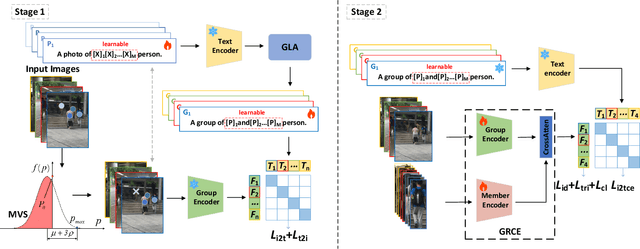


Abstract:Group Re-Identification (Group ReID) aims matching groups of pedestrians across non-overlapping cameras. Unlike single-person ReID, Group ReID focuses more on the changes in group structure, emphasizing the number of members and their spatial arrangement. However, most methods rely on certainty-based models, which consider only the specific group structures in the group images, often failing to match unseen group configurations. To this end, we propose a novel Group-CLIP UncertaintyModeling (GCUM) approach that adapts group text descriptions to undetermined accommodate member and layout variations. Specifically, we design a Member Variant Simulation (MVS)module that simulates member exclusions using a Bernoulli distribution and a Group Layout Adaptation (GLA) module that generates uncertain group text descriptions with identity-specific tokens. In addition, we design a Group RelationshipConstruction Encoder (GRCE) that uses group features to refine individual features, and employ cross-modal contrastive loss to obtain generalizable knowledge from group text descriptions. It is worth noting that we are the first to employ CLIP to GroupReID, and extensive experiments show that GCUM significantly outperforms state-of-the-art Group ReID methods.
Discrete-Time Modeling and Handover Analysis of Intelligent Reflecting Surface-Assisted Networks
Mar 12, 2024Abstract:Owning to the reflection gain and double path loss featured by intelligent reflecting surface (IRS) channels, handover (HO) locations become irregular and the signal strength fluctuates sharply with variations in IRS connections during HO, the risk of HO failures (HOFs) is exacerbated and thus HO parameters require reconfiguration. However, existing HO models only assume monotonic negative exponential path loss and cannot obtain sound HO parameters. This paper proposes a discrete-time model to explicitly track the HO process with variations in IRS connections, where IRS connections and HO process are discretized as finite states by measurement intervals, and transitions between states are modeled as stochastic processes. Specifically, to capture signal fluctuations during HO, IRS connection state-dependent distributions of the user-IRS distance are modified by the correlation between measurement intervals. In addition, states of the HO process are formed with Time-to-Trigger and HO margin whose transition probabilities are integrated concerning all IRS connection states. Trigger location distributions and probabilities of HO, HOF, and ping-pong (PP) are obtained by tracing user HO states. Results show IRSs mitigate PPs by 48% but exacerbate HOFs by 90% under regular parameters. Optimal parameters are mined ensuring probabilities of HOF and PP are both less than 0.1%.
Analysis of Intelligent Reflecting Surface-Enhanced Mobility Through a Line-of-Sight State Transition Model
Mar 12, 2024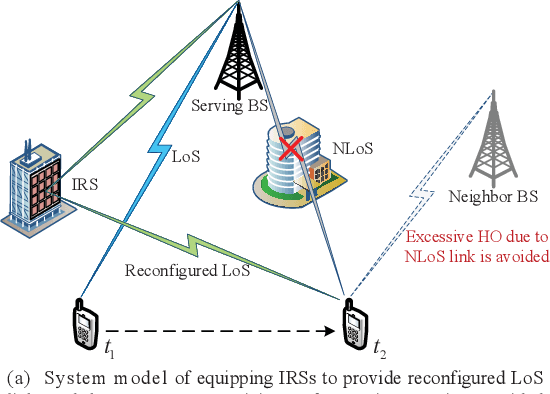
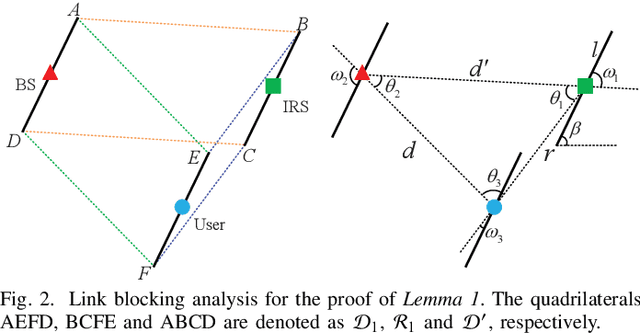
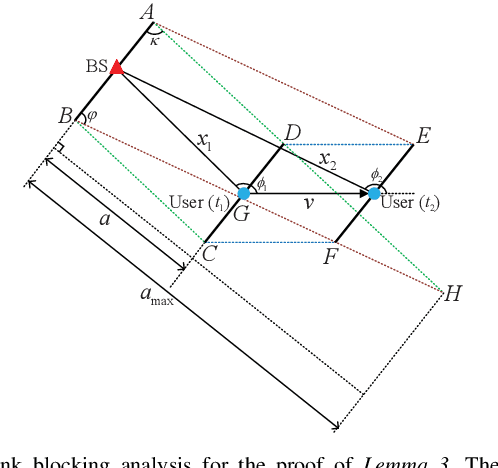
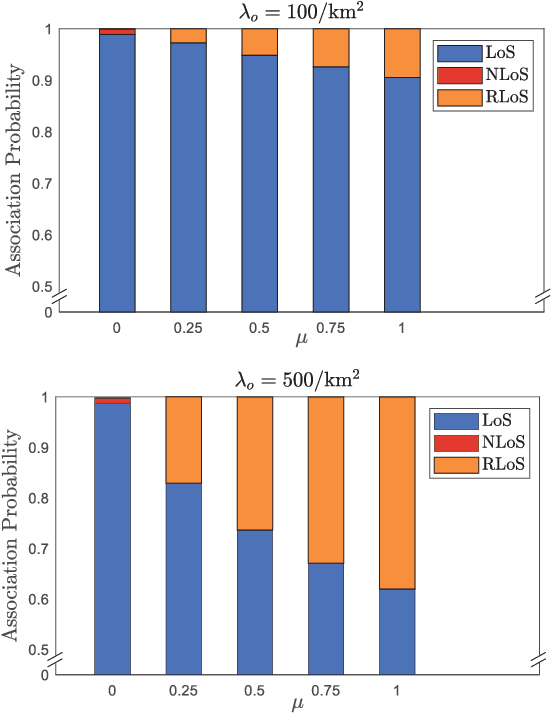
Abstract:Rapid signal fluctuations due to blockage effects cause excessive handovers (HOs) and degrade mobility performance. By reconfiguring line-of-sight (LoS) Links through passive reflections, intelligent reflective surface (IRS) has the potential to address this issue. Due to the lack of introducing blocking effects, existing HO analyses cannot capture excessive HOs or exploit enhancements via IRSs. This paper proposes an LoS state transition model enabling analysis of mobility enhancement achieved by IRS-reconfigured LoS links, where LoS link blocking and reconfiguration utilizing IRS during user movement are explicitly modeled as stochastic processes. Specifically, the condition for blocking LoS links is characterized as a set of possible blockage locations, the distribution of available IRSs is thinned by the criteria for reconfiguring LoS links. In addition, BSs potentially handed over are categorized by probabilities of LoS states to enable HO decision analysis. By projecting distinct gains of LoS states onto a uniform equivalent distance criterion, mobility enhanced by IRS is quantified through the compact expression of HO probability. Results show the probability of dropping into non-LoS decreases by 70% when deploying IRSs with the density of 93/km$^2$, and HOs decrease by 67% under the optimal IRS distributed deployment parameter.
LS-DYNA Machine Learning-based Multiscale Method for Nonlinear Modeling of Short Fiber-Reinforced Composites
Jan 06, 2023Abstract:Short-fiber-reinforced composites (SFRC) are high-performance engineering materials for lightweight structural applications in the automotive and electronics industries. Typically, SFRC structures are manufactured by injection molding, which induces heterogeneous microstructures, and the resulting nonlinear anisotropic behaviors are challenging to predict by conventional micromechanical analyses. In this work, we present a machine learning-based multiscale method by integrating injection molding-induced microstructures, material homogenization, and Deep Material Network (DMN) in the finite element simulation software LS-DYNA for structural analysis of SFRC. DMN is a physics-embedded machine learning model that learns the microscale material morphologies hidden in representative volume elements of composites through offline training. By coupling DMN with finite elements, we have developed a highly accurate and efficient data-driven approach, which predicts nonlinear behaviors of composite materials and structures at a computational speed orders-of-magnitude faster than the high-fidelity direct numerical simulation. To model industrial-scale SFRC products, transfer learning is utilized to generate a unified DMN database, which effectively captures the effects of injection molding-induced fiber orientations and volume fractions on the overall composite properties. Numerical examples are presented to demonstrate the promising performance of this LS-DYNA machine learning-based multiscale method for SFRC modeling.
* Final version of this manuscript is published in Journal of Engineering Mechanics. Wei, H., Wu, C. T., Hu, W., Su, T. H., Oura H., Nishi, M., Naito T., Chung S., Shen L. (2023). LS-DYNA machine learning-based multiscale method for nonlinear modeling of short-fiber-reinforced composites. Journal of Engineering Mechanics. 149(3): 04023003. https://doi.org/10.1061/JENMDT.EMENG-6945
Intelligent multiscale simulation based on process-guided composite database
Mar 20, 2020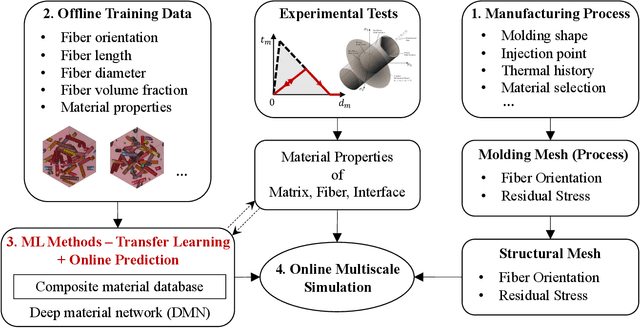
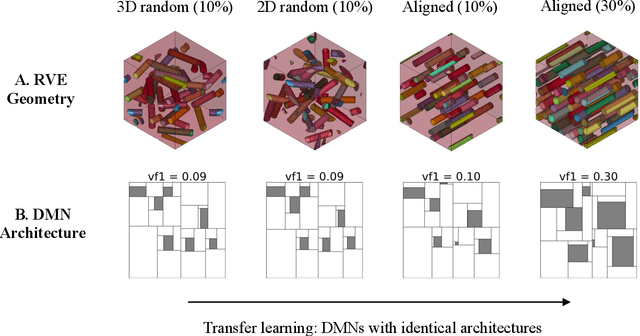

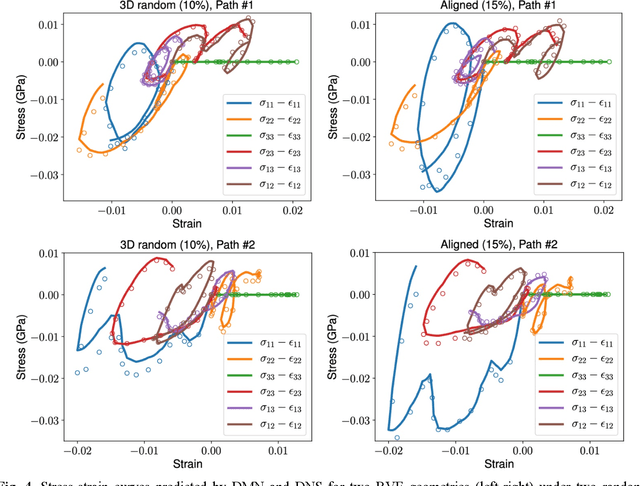
Abstract:In the paper, we present an integrated data-driven modeling framework based on process modeling, material homogenization, mechanistic machine learning, and concurrent multiscale simulation. We are interested in the injection-molded short fiber reinforced composites, which have been identified as key material systems in automotive, aerospace, and electronics industries. The molding process induces spatially varying microstructures across various length scales, while the resulting strongly anisotropic and nonlinear material properties are still challenging to be captured by conventional modeling approaches. To prepare the linear elastic training data for our machine learning tasks, Representative Volume Elements (RVE) with different fiber orientations and volume fractions are generated through stochastic reconstruction. More importantly, we utilize the recently proposed Deep Material Network (DMN) to learn the hidden microscale morphologies from data. With essential physics embedded in its building blocks, this data-driven material model can be extrapolated to predict nonlinear material behaviors efficiently and accurately. Through the transfer learning of DMN, we create a unified process-guided material database that covers a full range of geometric descriptors for short fiber reinforced composites. Finally, this unified DMN database is implemented and coupled with macroscale finite element model to enable concurrent multiscale simulations. From our perspective, the proposed framework is also promising in many other emergent multiscale engineering systems, such as additive manufacturing and compressive molding.
 Add to Chrome
Add to Chrome Add to Firefox
Add to Firefox Add to Edge
Add to Edge